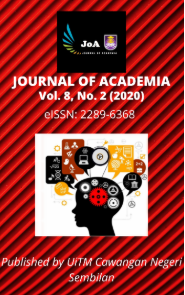Customer Waiting Time in Department of Labour, Kuala Terengganu: A Queuing Approach
Keywords:
Customer’s satisfaction, Queuing modelAbstract
Businesses adopt queuing mechanism as it can improve efficiency and provide economic use of resources. Some business segment that normally adapted queuing theory include assessing staff scheduling, productivity, performance, and customers waiting time. This article will adopt queuing theory to current service provided by Department of Labour, Kuala Terengganu. As the department is committed to provide quality services to its customer, the level of satisfaction and current queueing time need to be investigated. To achieve this, four elements in queueing theory – arrival rate, the queuing discipline, the service and also the cost structure are utilized. Arrival rate is measured as way in which customer arrives at this department and entered for receiving a service. Single server queuing model is known as infinite queue length model (exponential service) was used in this study. This model is based on certain assumptions about queuing, as the arrivals are described by Poisson probability distribution and arrive from infinite population. This study has demonstrated that, majority of the customers are dissatisfied with services offered and the major cause of dissatisfaction is the long waiting time. Sunday shows the busiest day at Department of Labour, Kuala Terengganu when there are too many customers and duty officer faced a hectic day on Sunday, followed by Thursday and Wednesday. Department of Labour, Kuala Terengganu needed to do the other internal procedures for reducing waiting times and thus ensuring an effective services system. This study recommended of adding a new checkout counter and hiring another employee to help duty officer improve the operation at Department of Labour, Kuala Terengganu.
References
Abiodun, R. (2017). Development of Mathematical Models for Predicting Customers Satisfaction in the Banking System with a Queuing Model Using Regression Method. American Journal of Operations Management and Information Systems, 2(2), 86-91.
Afolalu, S. A., Babaremu, K. O., Ongbali, S. O., Abioye, A. A., Abdulkareem, A., & Adejuyigbe, S. B. (2019). Overview Impact of Application of Queuing Theory Model on Productivity Performance in A Banking Sector. Journal of Physics: Conference Series, 1378(3), 032033.
Alenany, E., & El-Baz, M. A. (2017). Modelling a Hospital as a Queueing Network: Analysis for Improving Performance. International Journal of Industrial and Manufacturing Engineering, 11(5), 1181-1187.
Andersen, A. R., Nielsen, B. F., Reinhardt, L. B., & Stidsen, T. R. (2019). Staff optimization for time-dependent acute patient flow. European Journal of Operational Research, 272(1), 94-105.
Freeman, E. (2017). Queueing Theory in Practice: Performance Modeling for the Working Engineer. Retrieved from https://www.usenix.org/conference/lisa17/conference-program/presentation/freeman.
Hamka. (2018). Effect of Service Quality and Customer Satisfaction Patients in General Hospitals of Makassar City Region. Journal of Physics: Conf. Series, 1028, 012107.
Hernández-González, S., Ramírez-Tapia, R., & Jiménez-García, J. A. (2019). Analysis of the Productivity of a Shoe Production Line––Application of Queueing Theory and Lean Manufacturing. In Best Practices in Manufacturing Processes. Cham, Switzerland. Springer. pp. 367-388.
Magnus, U., Joseph, O. C., & Anthony, O. I. The application of queuing theory in the effective management of time in money deposit banks- A study of Zenith bank PLC in Enugu Metropolis. Research Journal of Social Science & Management, 5(8), 19-32.
Kadry, S., Bagdasaryan, A., & Kadhum, M. (2017). Simulation and analysis of staff scheduling in hospitality management. In 2017 IEEE 7th International Conference on Modeling, Simulation, and Applied Optimization (ICMSAO), 1-6.
Kotler, P. (2000). Marketing Management. 10th edn. The Miliennium Edition, Prentice Hall, International Inc. USA: pp. 36.
Lee, W., & Lambert, C. U. (2000). Impact of waiting time on evaluation of service quality and customer satisfaction in foodservice operations. Foodservice Research International, 12(4), 241-254.
Liu, S. A., Gong, J., Ma, L., & Yu, M. (2017). Influence of waiting times on customer loyalty and queueing behavior in call centers. In 2017 IEE 29th Chinese Control and Decision Conference (CCDC), 1130-1134.
Mwangi, S. K., & Ombuni, T. M. (2015). An empirical analysis of queuing model and queuing behaviour in relation to customer satisfaction at Jkuat students finance office. American Journal of theoretical and applied statistics, 4(4), 233-246.
Obinwanne, E. E. (2015). On Application of Queiung Models to Customers Management in Banking System. American Research Journal of Bio Sciences, 1(2), 14-20.
Parasuraman, A., Zeithaml, V.A & Berry, L.L. (1988). SERVQUAL: a multiple item scale for measuring consumer perceptions of service quality. Journal of Retailing, 64(5), 12-40.
Putra, R. O., Musoffa, S. F., Nurhasanah, S., Anggadjaja, E., & Santoso, H. (2017). QBLE—Theme park queueing system using wearable device. In 2017 IEEE 3rd International Conference on Engineering Technologies and Social Sciences (ICETSS), 1-6.
Qin, J., Xu, F., & Wang, R. (2019). Pre-service recovery: impact on customer satisfaction and acceptable waiting time. The Service Industries Journal, 39(1), 1-21.
Raj, S. Y., Karthee, K., Sundaram, S. K., Nishal, M., & Prasad, K. R. (2018). Increasing reliability and productivity in hypermarkets by queuing theory analysis and a smart shopping cart-based system. International Journal of Business Excellence, 14(4), 545-556.
Teas, R. K. (1993). Consumer expectations and the measurement of perceived service quality. Journal of professional services marketing, 8(2), 33-54.
Vahdani, B., Tavakkoli-Moghaddam, R., & Jolai, F. (2013). Reliable design of a logistics network under uncertainty: A fuzzy possibilistic-queuing model. Applied Mathematical Modelling, 37(5), 3254-3268.
Véricourt, F. D., & Jennings, O. B. (2011). Nurse staffing in medical units: A queueing perspective. Operations Research, 59(6), 1320-1331.
Xiao, Z., Zhou, J., Yan, J., He, C., Jiang, L., & Trigoni, N. (2018). Performance evaluation of IEEE 802.15. 4 with real time queueing analysis. Ad Hoc Networks, 73, 80-94.
Yusuf, M. O., & Kazeem, A. O. (2015). Queuing Theory and Customer Satisfaction: A Review of Peformance, Trends and Application in Banking Practice (A Study of First Bank Plc Gwagwalada, Abu Branch). European Journal of Business and Management, 7(35), 91-96.
Downloads
Published
Issue
Section
License
Copyright (c) 2020 Journal of Academia

This work is licensed under a Creative Commons Attribution-NonCommercial-NoDerivatives 4.0 International License.












